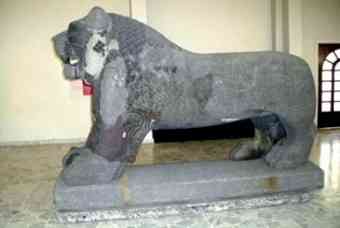The giant basalt lion statue sitting in the hall of Hama National Museum is a wonder of archaeology and sculpture that tells the story of three thousand years of human civilization.
 Animal sculptures represented an important part of the history of the Aramaic Kingdom that prospered in Syria, and particularly in the city of Aram (currently the modern city of Hama), said Director of Hama Directorate of Archeology.
Animal sculptures represented an important part of the history of the Aramaic Kingdom that prospered in Syria, and particularly in the city of Aram (currently the modern city of Hama), said Director of Hama Directorate of Archeology.
Aramaic animal sculptures were of considerable size, mostly depicting lions. Originally found in temples, they were later used to decorate the facades of palaces. An example of this can be seen in the remains of two giant basalt lions which decorated the main gate of the Aramaic royal palace constructed around 900 BC in Hama.
A Danish expedition excavating in Hama between 1931 and 1938 found the remains of the lions in poor condition and transported them to Copenhagen Museum in Denmark for restoration, where the remains were merged into a single statue.
The statue remained in Copenhagen Museum for over 50 years, until an agreement was made between Syria and Denmark in the 1990's to return the statue home, which has been on display at Hama National Museum ever since.
The 10-ton statue is around 3000 years old. It's 3.5 meters high, 5 meters long and 1.5 meters wide, making it one of the largest archeological artifacts in Syria.
The technique used in sculpting the statue shows attention to detail, accentuating the fangs, mane, slender body, large head and extended claws of the lion which is depicted as preparing to pounce.
The use of basalt rock used to make this statue is of interest, as this stone is long-lived and very hard. Taking into account the simplicity of the metal instruments used at the period of its making, the statue must have taken remarkable effort to be completed.
Source: Global Arab Network